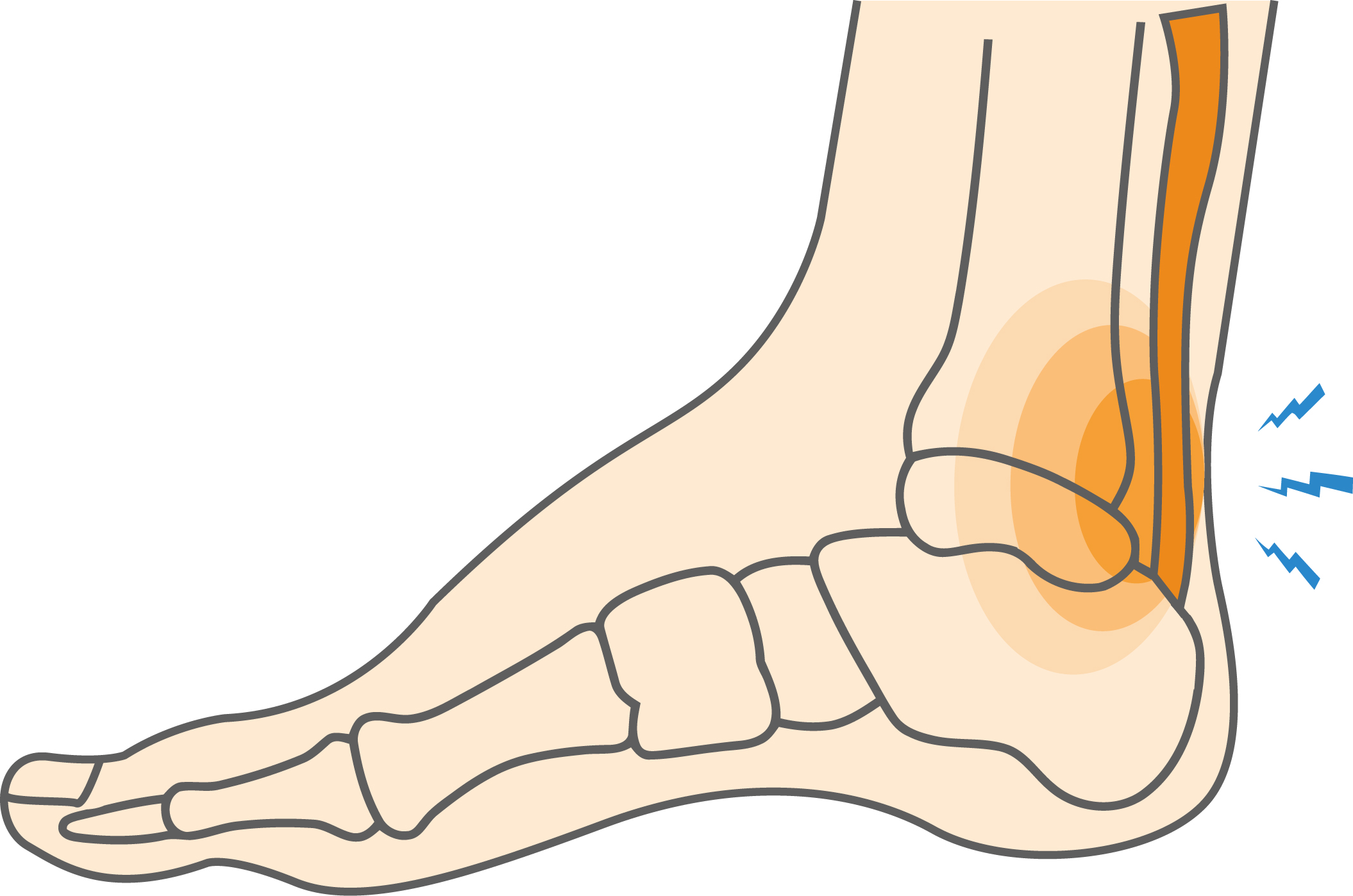The calf has two muscles: the gastrocnemius and the soleus. They meet to form the Achilles tendon, the large fibrous cord that runs down the back of your lower leg. It connects the calf muscles to the heel bone. The Achilles tendon is used for push-off strength, balance, and power while standing, walking, running, and jumping. This tendon can be strained or partially torn, making it difficult to walk or run. A sports injury can also lead to Achilles overuse and strain.
Achilles Tendonitits Strain Causes, Symptoms & Treatment Options
The calf has two muscles: the gastrocnemius and the soleus. They meet to form the Achilles tendon, the large fibrous cord that runs down the back of your lower leg. It connects the calf muscles to the heel bone. The Achilles tendon is used for push-off strength, balance, and power while standing, walking, running, and jumping. This tendon can be strained or partially torn, making it difficult to walk or run. Common causes of Achilles tendonitis strain include Achilles overuse, tendon microtears, and calf tightness.
Overview
Overview

What causes Achilles Strain Causes, Symptoms & Treatment Options?
An Achilles tendon strain is associated with forceful muscle contraction at the same time the muscle is being stretched. This injury frequently occurs in athletes who play sports that involve running, jumping, and sudden starts and stops. Achilles tendonitis strain often stems from tendon microtears or calf tightness due to intense physical activity or inadequate warm-up.
Achilles tendon strains are most common in these sports:
- Tennis and other racket sports
- Soccer
- Running
Symptoms
Achilles tendon strains usually come on suddenly. Athletes with this injury find it difficult to push off the injured leg when walking. The most common symptom of an Achilles tendon strain is pain in the back of the heel. Other symptoms include difficulty walking and exercising. In many cases, these symptoms are a result of cumulative Achilles overuse.
When to see a doctor
If you experience an injury and have pain in the back of your heel or leg, or if you experience difficulty walking due to pain or weakness during push off, you should see your doctor. During your visit, your doctor will inspect your calf and make sure that you do not have signs of rupture, such as tenderness, swelling, a gap in the tendon, or shortening of the calf. To help make a diagnosis, your doctor may conduct the “Thompson test,” a physical exam in which the patient lies face down with both knees flexed. The foot associated with the rupture often hangs at a different angle than the uninjured leg. Squeezing the calf muscle of a leg with a ruptured Achilles tendon does not move the foot on the injured leg. If you have an Achilles strain or partial tear, your foot will move up and down normally. Your doctor may also order imaging tests, such as a magnetic resonance imaging (MRI) test, to make sure you do not have an Achilles tendon rupture.
Non-operative treatment
Treatment of Achilles tendon strains is almost always non-operative.
Conservative treatments may include:
- Using crutches to take weight off the calf muscles and tendons
- Nonsteroidal anti-inflammatory drugs (NSAIDS), such as ibuprofen and naproxen, to relieve pain
- Applying ice to the affected area
- Compression
- Wearing a special brace or boot to prevent movement of the lower leg and ankle
- Physical therapy or massage exercises
Try these exercises to help address your condition:
Below is a PDF of the Exercise Program
Surgical Treatment
If an Achilles tendon strain doesn’t improve with conservative treatment after several months, your doctor may refer you to an orthopaedic surgeon. Surgery may be needed to remove scar tissue, repair the damaged tendon, extend the calf muscle, or address other issues identified by your doctor.
Recovery
Recovery from an Achilles strain will vary depending on the extent of damage to the tendon. For some athletes, strains will resolve in a matter of days with treatment. For others, a much longer recovery time will be required before they can return to play. Physical therapy will be an important part of the rehabilitation process. A sports injury that involves Achilles overuse or untreated tendon microtears may result in extended healing timelines.
GET BACK TO WHAT YOU LOVE. FASTER
Sources
https://orthoinfo.aaos.org/en/diseases–conditions/achilles-tendinitis/
https://www.mayoclinic.org/diseases-conditions/achilles-tendinitis/symptoms-causes/syc-20369020
https://viewmedica.com/vm/index/brochure/68/achillesinjury/en
https://www.healthline.com/health/achilles-tendinitis#causes
https://physioworks.com.au/careers/physiotherapist-job-brisbane/
Frequently Asked Questions
Can I continue to exercise following an Achilles strain?
It's important to avoid activities that worsen your symptoms. Low-impact exercises like swimming or cycling may be safer alternatives, but you should consult your doctor or physical therapist before continuing any physical activity. Ignoring the pain and pushing through it could lead to more severe injury.
How long does it take to recover from an Achilles strain?
Recovery time depends on the severity of the strain and how early treatment begins. Mild cases may resolve within a few days to weeks with proper care, while moderate to severe strains may take several months to fully heal. Adhering to a structured rehabilitation plan, including physical therapy, can speed up recovery.
What are the signs that my Achilles strain may be something more serious like an achilles rupture?
Severe pain associated with swelling and inability to push off may be signs of something more serious like a tendon rupture.. If you experience a sudden "pop" or loss of function, seek medical attention immediately to rule out a rupture.
Can an Achilles strain be prevented?
Yes, preventive steps can reduce your risk. These include regular calf stretching and strengthening exercises, proper warm-up before activities, wearing supportive footwear, and gradually increasing the intensity of physical activity. Maintaining flexibility and strength in the lower leg muscles is key to preventing Achilles overuse injuries.

